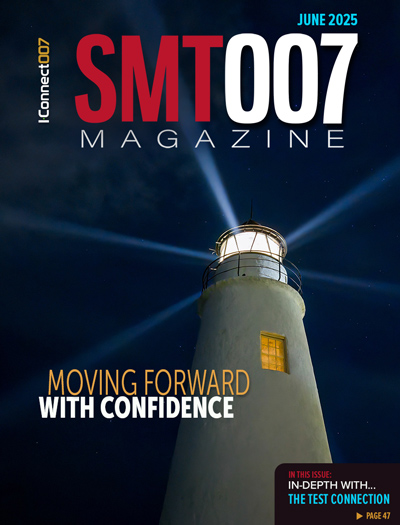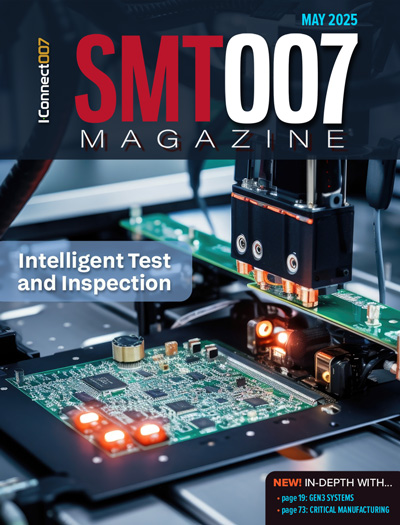-

-
News
News Highlights
- Books
Featured Books
- smt007 Magazine
Latest Issues
Current Issue
What's Your Sweet Spot?
Are you in a niche that’s growing or shrinking? Is it time to reassess and refocus? We spotlight companies thriving by redefining or reinforcing their niche. What are their insights?

Moving Forward With Confidence
In this issue, we focus on sales and quoting, workforce training, new IPC leadership in the U.S. and Canada, the effects of tariffs, CFX standards, and much more—all designed to provide perspective as you move through the cloud bank of today's shifting economic market.

Intelligent Test and Inspection
Are you ready to explore the cutting-edge advancements shaping the electronics manufacturing industry? The May 2025 issue of SMT007 Magazine is packed with insights, innovations, and expert perspectives that you won’t want to miss.
- Articles
- Columns
- Links
- Media kit
||| MENU - smt007 Magazine
Rehm Launches Flexible 2-in-1 Solution for Reflow Soldering
July 27, 2015 | Paul Wild, Rehm Thermal Systems GmbHEstimated reading time: 2 minutes
The desire for higher throughput and better integration of SMD lines require new technological solutions. In line with this, Rehm Thermal Systems has introduced a vacuum unit that enables convection soldering processes with or without vacuum – with only one soldering system.
Energy-efficient, low-maintenance and voidless, the new solution features two technologies—the convection reflow soldering system VisionXP+ and a vacuum chamber—that had been united to provide this new option.
As soon as the solder is molten—and while the solder is still in the optimum molten state—the VisionXP+ with vacuum option reliably removes voids and gas emissions. Void content of less than 2% can be realised with a vacuum between 100 mbar and 10 mbar (Figure 1a). For an exact setting of the process parameters the vacuum level is measured directly in the process chamber. Pressure gradient and the speed of the vacuum process can be set individually and profile parameters can be saved. The mechanical system construction allows to optionally use the vacuum or to apply it as a classic convection soldering system (Figure 1b).
Figure 1: X-ray images of a QFN44 solder joint following soldering process (a) with vacuum and (b) without vacuum with the VisionXP+ Vac system.
The vacuum chamber is installed (Figure 2) as an enhancement to the available peak zones. The integrated pyrolysis and separate filtering of the atmosphere extracted from the vacuum chamber makes maintenance and cleaning easy. The vertical travel range and automatic service positions of the vacuum chamber allowing good access to the internal mechanisms during maintenance periods and minimises downtimes and reduces maintenance effort.
Figure 2: A convection soldering system of type VisionXP+ Vac with vacuum chamber.
The system has a higher throughput by a second transport track and comes with a tripartite transport system: pre-heating/peak area, vacuum unit and cooling zone, and optional with a central support for particularly wide boards. Transportation speed in the cooling zone can be reduced, and cooling time of components can be extended to assure optimum temperature for the subsequent process steps.
All heating zones are regulated individually and thermally separated from each other to assure a stable reflow process, flexible pressure and temperature profile guidance. Figure 3 shows a temperature profile with the vacuum process switched on. With a very low vacuum of 10 mbar profile settings ≤3K/s heating, tL≤90s, TP≤240°C had been fulfilled. With the integrated heating in the chamber, the component temperature can be adapted to the most common standards.
Figure 3: Pressure and temperature profile of a soldering process with the VisionXP+ Vac.
In order to identify a suitable combination of condensation or convection soldering and vacuum technology, the individual aims should be analysed. Table 1 compares several important features of the two vacuum soldering procedures.
Table 1: Comparison convection and condensation soldering systems with vacuum.
Suggested Items
Knocking Down the Bone Pile: Addressing End-of-life Component Solderability Issues, Part 4
07/15/2025 | Nash Bell -- Column: Knocking Down the Bone PileIn 1983, the Department of Defense identified that over 40% of military electronic system failures in the field were electrical, with approximately 50% attributed to poor solder connections. Investigations revealed that plated finishes, typically nickel or tin, were porous and non-intermetallic.
SHENMAO Strengthens Semiconductor Capabilities with Acquisition of PMTC
07/10/2025 | SHENMAOSHENMAO America, Inc. has announced the acquisition of Profound Material Technology Co., Ltd. (PMTC), a premier Taiwan-based manufacturer of high-performance solder balls for semiconductor packaging.
KYZEN to Highlight Understencil and PCB Cleaners at SMTA Querétaro Expo and Tech Forum
07/09/2025 | KYZEN'KYZEN, the global leader in innovative environmentally responsible cleaning chemistries, will exhibit at the SMTA Querétaro Expo & Tech Forum, scheduled to take place Thursday, July 24, at Centro de Congresos y Teatro Metropolitano de Querétaro.
Driving Innovation: Direct Imaging vs. Conventional Exposure
07/01/2025 | Simon Khesin -- Column: Driving InnovationMy first camera used Kodak film. I even experimented with developing photos in the bathroom, though I usually dropped the film off at a Kodak center and received the prints two weeks later, only to discover that some images were out of focus or poorly framed. Today, every smartphone contains a high-quality camera capable of producing stunning images instantly.
Hands-On Demos Now Available for Apollo Seiko’s EF and AF Selective Soldering Lines
06/30/2025 | Apollo SeikoApollo Seiko, a leading innovator in soldering technology, is excited to spotlight its expanded lineup of EF and AF Series Selective Soldering Systems, now available for live demonstrations in its newly dedicated demo room.


